The Economics and Statistics Division maintains archives of previous publications for accountability purposes, but makes no updates to keep these documents current with the latest data revisions from Statistics Canada. As a result, information in older documents may not be accurate. Please exercise caution when referring to older documents. For the latest information and historical data, please contact the individual listed to the right.
<--- Return to Archive
For additional information relating to this article, please contact:
January 07, 2022FOOD INSECURITY, 2019 Statistics Canada has published updated indicators of food security and food insecurity. Data are for the 2018 and 2019 reference periods of the Canadian Income Survey (CIS). Estimates from this source do not include the territories.
This data includes 'marginal food insecurity', which had previously been counted as part of 'food secure' households. Marginal food insecurity exists when (at some point during the reference year) there is a worry about running out of food and/or limited food selection due to lack of money for food. 'Moderate food insecurity' refers to households for whom there is a time during the year when the household had to compromise on the quality or quantity of food consumed due to a lack of money for food. 'Severe food insecurity' exists in a year when a household had to miss meals, reduce food intake and, at the most extreme, go day(s) without food. A household is considered 'food secure' during a year if the household had access at all times throughout the year to enough food for an active, healthy life for all household members. Statistics Canada reports food insecurity as those who experience moderate or severe food insecurity.
Across Canada, 84.4% of all persons were considered to be food secure in 2019. Those living in Quebec are the most food secure at 89.4% while Nova Scotians are the least food secure at 81.2% in 2019.
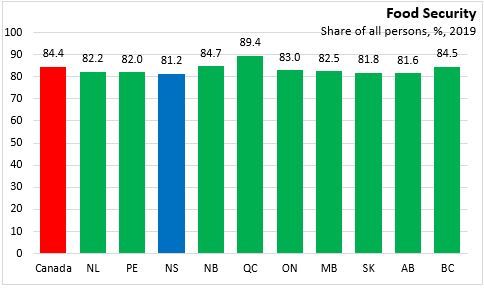
Food insecurity is classified into marginal, moderate or severe categories.
Across Canada, 3.2% of persons experienced severe food insecurity in 2019. Nova Scotia has the highest share of severe food insecurity at 4.6% of persons. The lowest severe food insecurity is found in Quebec at 1.9% of persons.
Moderate food insecurity affected 7.4% of Canadians with the highest share in Alberta (9.0%) and the lowest in Quebec (5.2%). Moderate food insecurity affected 8.4% of persons in Nova Scotia.
Marginal food insecurity affected 5.0% of Canadians, ranging from a high of 6.0% in Newfoundland and Labrador to a low of 3.5% in Quebec. In 2019, 5.8% of Nova Scotians experienced marginal food insecurity.

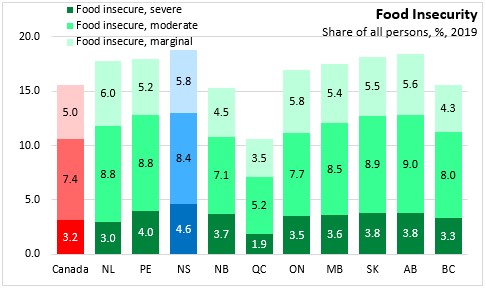
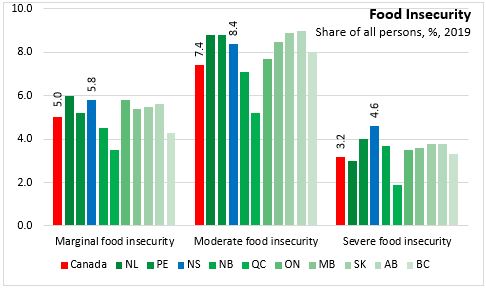
In 2019 there were 123,000 Nova Scotians who lived with moderate or severe food insecurity (13.0% of persons). This was down 15.2% from the 145,000 persons living with moderate or severe food insecurity in 2018 (15.5% of persons). Across Canada, the population experiencing moderate or severe food insecurity fell by 6.2% with declines in 8 of 10 provinces. Moderate or severe food insecurity declined fastest in Quebec and Nova Scotia while only Saskatchewan and Prince Edward Island reported increases in moderate or severe food insecurity.
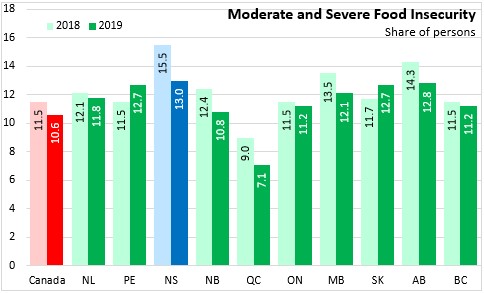
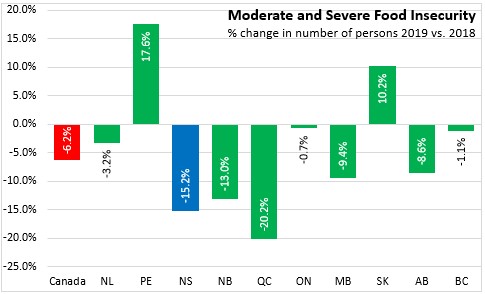
Food security varies across demographic groups. In Nova Scotia, elderly families and elderly females living alone, and couple families, reported the highest rates of food security.
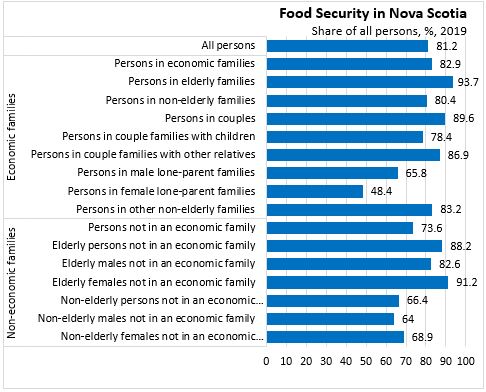
In 2019, 13.0% of Nova Scotians (123,000 persons) reported moderate or severe food insecurity. There were 79,000 persons who experienced moderate food insecurity and another 44,000 experienced severe food insecurity.
Persons in female lone-parent families (33.3%) and non-elderly males not in an economic family (26.5%) reported the highest rates of moderate or severe food insecurity. In 2019 this reflected 14,000 persons in female lone-parent families and 15,000 non-elderly males.
Couple families with children were the largest number of persons (41,000) who experienced moderate or severe food insecurity, which was 14.6% of the population in couple families with children.
Due to data suppression, the full degree to which families are food insecure (marginal, moderate or severe) is not available for all family types.
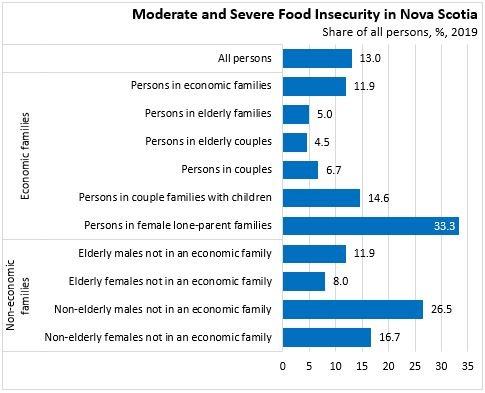
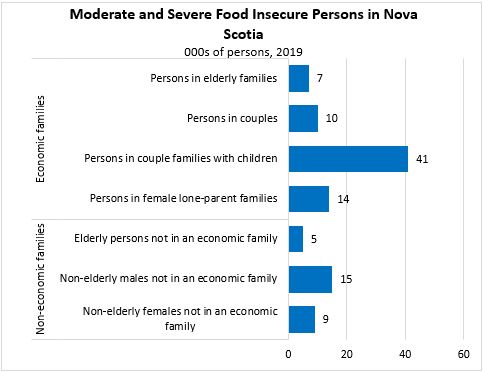
Nova Scotians who are not part of an economic family (i.e. those living alone or with roommates) are among the least food secure across the country. In 2019, 82.9% persons in economic families were considered food secure, reflecting a higher than average rate of food security among elderly families and a below average rate for non-elderly families.
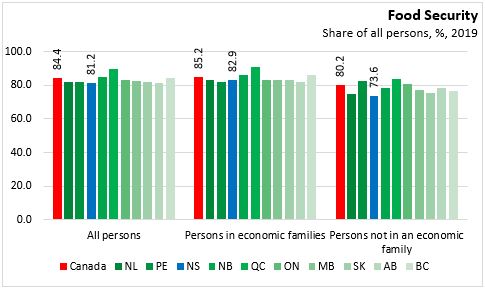
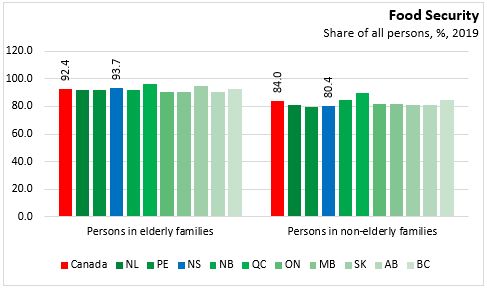
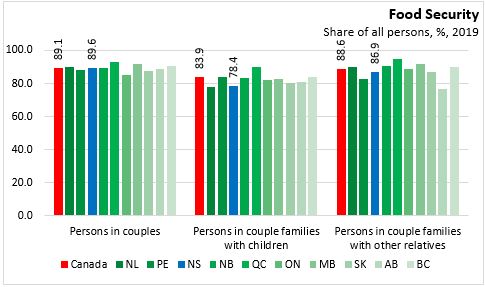
Lone parent families are also among the least food secure in every province. In Nova Scotia only 48.4% of those in female lone-parent families reported they were food secure in 2019. Data are supressed for male lone-parent families in Newfoundland and Labrador and Prince Edward Island.
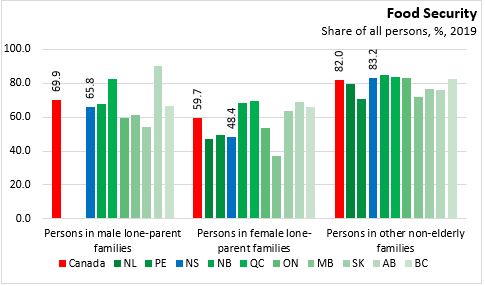
Food security was higher for elderly females not in an economic family than it was for males in Nova Scotia in 2019. Non-elderly males and females in Nova Scotia experience higher rates of food insecurity than the national average, with the lowest rates of food security across the provinces.
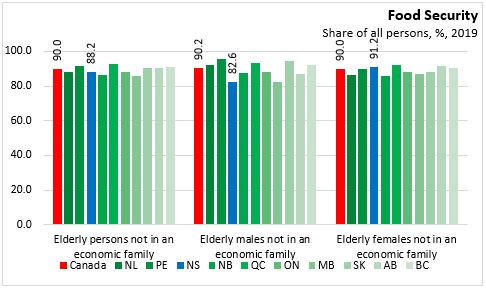
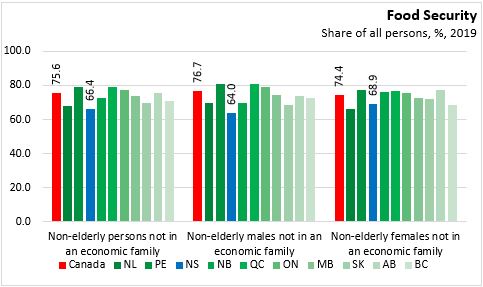
Food security was below the national average for every age group in Nova Scotia, with the gap narrowing for older age cohorts.
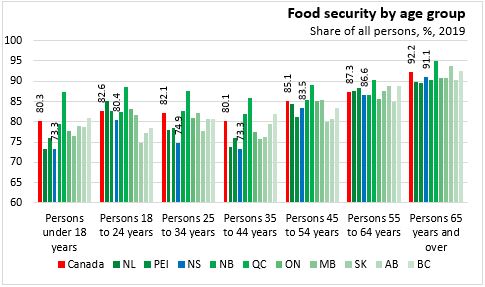
Nova Scotians also reported lower food security relative to the national average for both sexes, with females reporting marginally higher food security than males in Nova Scotia.
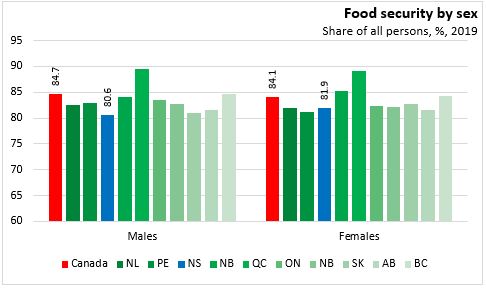
Source: Statistics Canada. Table 13-10-0835-01 Food insecurity by age group and sex; Table 13-10-0834-01 Food insecurity by economic family type
Canadian Income Survey: Food insecurity and unmet health care needs, 2018 and 2019
<--- Return to Archive